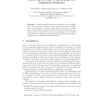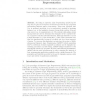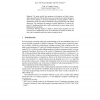SAS
2001
Springer
14 years 11 months ago
2001
Springer
We present the implementation of cTI, a system for universal left-termination inference of logic programs, which heavily relies on static analysis techniques. Termination inference...
LPNMR
2001
Springer
14 years 11 months ago
2001
Springer
Abstract. Considering different implication operators, such as Lukasiewicz, G¨odel or product implication in the same logic program, naturally leads to the allowance of several a...
LPNMR
2001
Springer
14 years 11 months ago
2001
Springer
Abstract. According to Dynamic Logic Programming (DLP), knowledge may be given by a sequence of theories (encoded as logic programs) representing different states of knowledge. Th...
ICLP
2001
Springer
14 years 11 months ago
2001
Springer
Multi-adjoint logic programs has been recently introduced [9, 10] as a generalization of monotonic logic programs [2, 3], in that simultaneous use of several implications in the ru...
EPIA
2001
Springer
14 years 11 months ago
2001
Springer
Abstract. Multi-adjoint logic program generalise monotonic logic programs introduced in [1] in that simultaneous use of several implications in the rules and rather general connect...
ICLP
2003
Springer
15 years 21 hour ago
2003
Springer
We equip ordered logic programs with negation as failure, using a simple generalization of the preferred answer set semantics for ordered programs. This extension supports a conven...
ICLP
2003
Springer
15 years 21 hour ago
2003
Springer
In recent research on nonmonotonic logic programming, repeatedly strong equivalence of logic programs P and Q has been considered, which holds if the programs P ∪ R and Q ∪ R h...
CIA
2003
Springer
15 years 1 days ago
2003
Springer
Abstract. Logic programming has often been considered less than adequate for modelling the dynamics of knowledge changing over time. In this paper we describe Evolving Logic Progra...
CAEPIA
2003
Springer
15 years 1 days ago
2003
Springer
Abstract. Multi-adjoint logic programs were recently proposed as a generalization of monotonic and residuated logic programs, in that simultaneous use of several implications in th...
ASP
2003
Springer
15 years 1 days ago
2003
Springer
Abstract. We define a translation of aggregate programs to normal logic programs which preserves the set of partial stable models. We then define the classes of definite and str...




